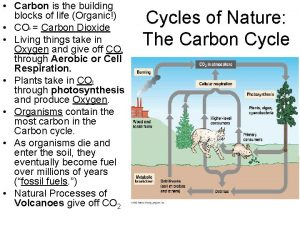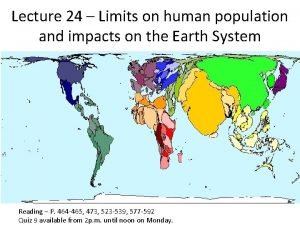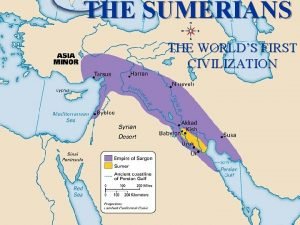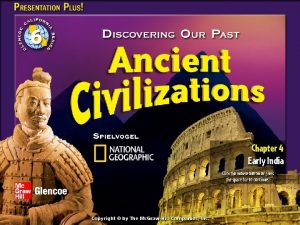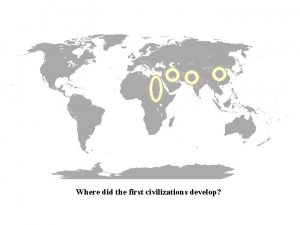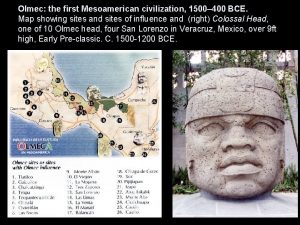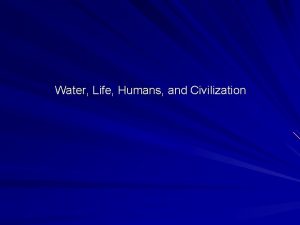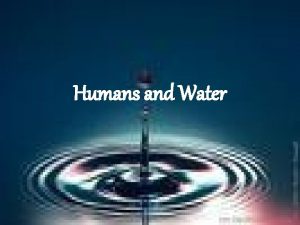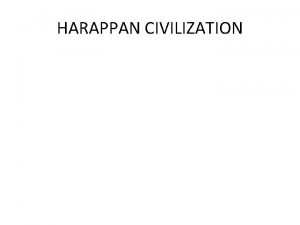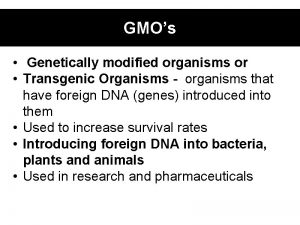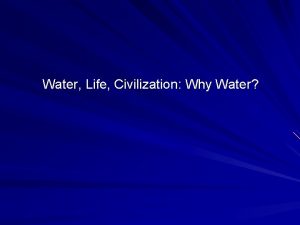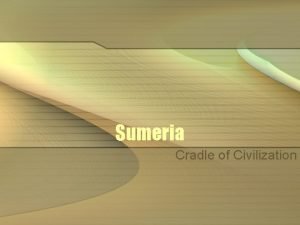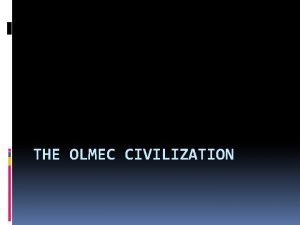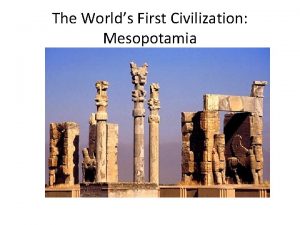Water Humans and Civilization The First Organisms Must






























- Slides: 30

Water, Humans, and Civilization

The First Organisms Must survive in low-oxygen environments Could not eat other organisms for food Assemble complex carbon compounds from simple Carbon compounds (CO 2) using external energy. Two energy sources: Light: Chemical reactions: Light and Chemical reactions photoautotrophs chemoautotrophs

The First Organisms Light: Chemical reactions: The First organisms: Evidence: photoautotrophs chemoautotrophs Chemoautotrophs (Fe and S) microtubes in pillow lavas containing residual carbon

The Early Organisms Must survive in low-oxygen environments Could not eat other organisms for food Photosynthesizers: photoautotrophs Earliest: Blue-green algae/cyanobacteria Main effects: - Removal of carbon dioxide - production of oxygen

The Early Organisms Oldest macroscopic life: stromatolites sediments Cyanobacteria colonies Produced billions of tons of O 2 No immediate increase in atmospheric O 2 Stromatolites Oxygen O 2 combined with iron

Colonization of land: Ozone Layer Ozone Function: Screens harmful UV radiation First land plants 480 mya

Skipping Ahead Reptiles ~ 245 million years ago Mammals ~65 million years ago Primates ~30 million years ago Pre-humans ~5 -8 million years ago (hominids) Homo sapiens ~200, 000 years ago

Human Taxonomy Kingdom: Animalia Phylum: Chordata Class: Mammalia Order: Primata Family: Hominidae Genus: Homo Species: sapiens Hominids distinct adaptations which may have led to the development of the human species.

Lucy Age: 3. 2 million years Family: hominidae Genus/Species: Australopithicus Afarensis “The earliest celebrity” Innovation: Walking upright lead to further anatomical progression

Why Stand Up?

Hypotheses Postural Feeding Hypothesis Thermoregulatory Model Savanna Hypothesis

Savanna Hypothesis Uplift of the Himalayas altered the climate in Africa Lowered rainfall reduced African vegetation Distance between trees increased Hominids forced to spend more time on the ground Hominids developed the advantage of walking upright Bipedalism lead to further anatomical progression

Evolutionary Timeline Lack of consensus Paucity of Evidence - 25, 000 yrs

Scarcity of Fossil Evidence Homo sapiens are the only species to develop civilizations

Water and the Development of Human Civilization

Civilization q the settlement of people upon an area continuously cultivated and possessed, who live in buildings continuously inhabited with a common rule and economy, a common city, citadel or temple and, in some cases, a military and the development of writing. Possession Habitation Economy Citadel/Temple Military Writing

Civilization The first condition necessary to the settling of humans. A trustworthy supply of water

Earliest Civilizations and Water 1. Sumer/Mesopotamia Tigris-Euphrates rivers Egypt Nile river Indus Valley Indus river Developments Irrigation, cities, art, architecture, writing

Civilization: Before and After

Development Paleolithic (old stone age) was the first period in the development of human technology of the Stone Age. -2 million years ~12, 000 years Stone Tools Homo habilis

Development Neolithic (new stone age) was a period in the development of human technology that is traditionally the last part of the Stone Age -12, 000 -3500 years q Domestication q Pottery q Weaving q Hafted Axes Cause of the change?

Agriculture 20, 000 years ago Development Of Agriculture (systematic/irrigated) 8, 000 years ago Development was slow and variable

Neolithic Revolution food gatherers to food producers üSurplus Food Craftsmen Traders Technicians Specialized skills Diverse abilities Why Then?

Forced Adaptation Climate and Water Homo sapiens

Retreat of the Ice Italy Gibraltar Spain Turkey Africa

Consequences • Overpopulation of lands around the Mediterranean • Concentration of people into smaller areas • Overload of available resources üdepletion of plants üAnimal populations died back • new survival strategies ütill the earth üPooled resources üProtect/domesticate animals

Egypt and Mesopotamia Nile Jordan Tigris Euphrates Neolithic Founder Crops Wheat Barley Flax Chick Pea Lentil Domesticated animals: cows, goats, sheep, and pigs

Time Perspective tool users 2, 000 yrs agriculture 8, 500 yrs iron age 3, 000 yrs industrial revolution The Model T Moon landing 61 years

Miscellaneous Vinyl 1926 Saran Wrap 1953 Velcro 1955 Plastic Garbage Bags 1968 Caller ID patented 1982 First soft drinks in all-aluminum cans 1964

Life, Humans, Civilization, and Water Next: What’s So Special About Water?
 Water and water and water water
Water and water and water water What is multicellular and unicellular
What is multicellular and unicellular Competitive interaction
Competitive interaction Introduction of transport
Introduction of transport How do humans affect the water cycle
How do humans affect the water cycle Carbon is the building block of life
Carbon is the building block of life What percentage of humans are water
What percentage of humans are water First humans location
First humans location He must become greater i must become less
He must become greater i must become less Sumerian civilization
Sumerian civilization Indias first civilization
Indias first civilization Artifact คืออะไร
Artifact คืออะไร What was the first mesoamerican civilization
What was the first mesoamerican civilization First i must honor god second honor his name
First i must honor god second honor his name We must first seek to understand
We must first seek to understand The first person that we must see is mr.smith
The first person that we must see is mr.smith Hát kết hợp bộ gõ cơ thể
Hát kết hợp bộ gõ cơ thể Bổ thể
Bổ thể Tỉ lệ cơ thể trẻ em
Tỉ lệ cơ thể trẻ em Voi kéo gỗ như thế nào
Voi kéo gỗ như thế nào Chụp phim tư thế worms-breton
Chụp phim tư thế worms-breton Hát lên người ơi
Hát lên người ơi Các môn thể thao bắt đầu bằng từ đua
Các môn thể thao bắt đầu bằng từ đua Thế nào là hệ số cao nhất
Thế nào là hệ số cao nhất Các châu lục và đại dương trên thế giới
Các châu lục và đại dương trên thế giới Công thức tính thế năng
Công thức tính thế năng Trời xanh đây là của chúng ta thể thơ
Trời xanh đây là của chúng ta thể thơ Mật thư tọa độ 5x5
Mật thư tọa độ 5x5 Làm thế nào để 102-1=99
Làm thế nào để 102-1=99 độ dài liên kết
độ dài liên kết





